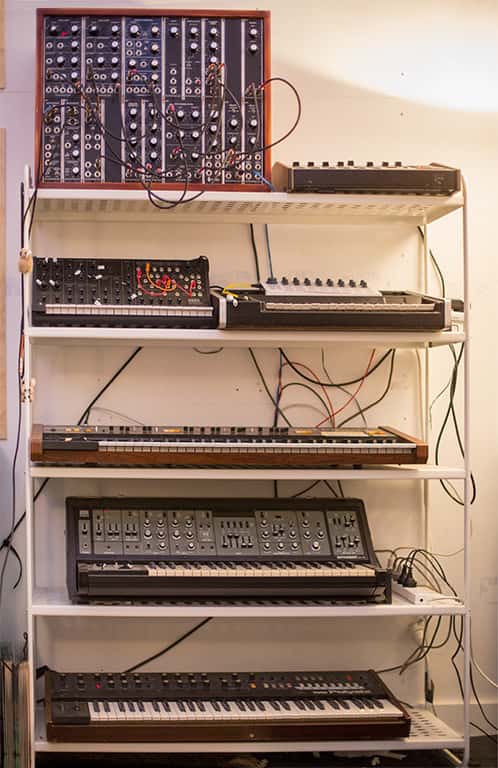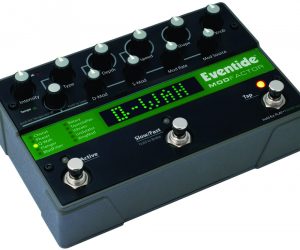
Wham! Bam! Thank You Schram
Hockey masks, megaphones, and a distaste for boring arrangements; Triple J alumnus Steven Schram cures The Voltaire Twins of any lingering demo-itis.
“Take a week to let them settle in,” was the advice the Voltaire Twins’ remember their producer Anna Laverty giving. “Because the first time you hear them, you’re going to get upset.”
She was laying familiar groundwork, preparing them to hear the album mixes due back from Steven Schram any day. The first song he sent back, they loved. “It was so much better,” said the male Voltaire, Jaymes, brother of Tegan. “It was this feeling of, ‘Well, I didn’t do that, but it’s so much better.’” The second song was a bit of a shock though. “He’d completely changed the genre and sawn a minute off,” said Jaymes. They eventually asked Schram to change it back, citing it was intended to be more of an ‘album track’, which he did.
Schram knows this pattern all too well, “that’s why I get fired all the time.” He’s lost count of how many times. Frankly, he’d be “disappointed” if he didn’t.
“I’m going for something,” he explains. “I’m not trying to play it safe. I’m trying to make your song feel like it’s going to jump out of the bushes and rip your face off.”
Sometimes he does the dirty work himself. He just fired himself from a job a week earlier: “There was 160 stereo channels. I’m not sifting through that amount of shit. If you can’t make a pop song with 48 tracks at the most, then there’s something fundamentally wrong with your arrangement or your technique.”
It’s not that he doesn’t want the work. He wants loads of it; he’s got mouths to feed and rent to pay — stuff you can’t cash in an ARIA award for. But for him, being successful also means enjoying the process. If that requires driving a few people away in order to stick to his guns, so be it. The work speaks for itself; maybe the next artist will have more balls.
NOTHING’S CLEARER THAN A CUT
Schram’s liberal attitude towards arrangements is partly because he doesn’t see any clear definitions between engineering, producing and mixing, “it’s all one big continuum for me.” He’d like to think he’s staying true to the band’s vision. But if he feels like it needs to be faster… he’ll speed it up. If he thinks the chorus should be in a different spot… he’ll move it. And at the end of the day, if it doesn’t work, “I’ve got a copy of it, so I can always put it back.”
It can be a bit confronting for some, especially when the only communication with Schram has been via email and their arrangements come back hacked to bits. Let’s just say, there’s no point hiring him if you have a case of demo-itis. On the other hand, for people that know what they’re getting into, Schram is a mix weapon who’s unafraid to slam convention up the wazoo. His studio is called Bangkok Ninja Academy for goodness sake!
The Twins are no strangers to production, and know all too well the dangers of demo-itis — something they’ve learnt to deal with by being on the other side of the glass. “On previous records where we’ve demoed the songs heavily, I’ve definitely had fights with producers,” said Jaymes. “But then I co-produced another band who were exactly how I used to be.” Just like Schram, he remembers getting stuck into their arrangements and the penny dropping, “I told them, ‘It doesn’t need all of that, cut this and get to the chorus quicker.’ You know when you realise you’re talking like your mum? It felt like that. I could see me in them. I had to realise none of my opinions were correct.”
Jaymes still has doubts about that second song. Every now and again, he thinks it would have been nice to keep it. Even to use as a remix; it was that different. Meanwhile, Schram has cursed, kicked the wall and moved on: “If the client’s happy, I’m happy. The next day you’re on a completely different band, in a completely different genre, with a completely different mindset.” Let someone else agonise over the ‘should haves’.

TRIPLE J IN THE HOUSE
Schram was an in-house engineer at Triple J for years. But the experience didn’t leave him with some secret Triple J sauce to apply to every mix, it taught him the importance of performance. Every Wednesday, he used to record, mix and master a three-song live set to be played on Home & Hosed that night. And every Wednesday it would be different. “Sometimes it sounded excellent and sometimes it sounded like shit,” he recalled. “You’d scratch your head going, ‘What is it?’ It was the same room, same pres, same mics, same everything. The only variable was the band. The ones that had a good time, played real well, and had good songs, they sounded great. It was a real struggle for the ones that didn’t. As soon as I started getting everyone to play their little hearts out, the records sounded better.”
Soundpark Studios in Northcote, where he often records, has a megaphone and glow-in-the-dark Friday the 13th mask on hand. Schram reckons when you’re screaming at someone through the glass with a hockey mask on, people tend to do what they’re asked. “And as much as I can get down live in one take, the better things work out,” he reckons. “If there’s not a lot of magic to work with, I don’t think you can overdub your way out of trouble.”
The importance of performance is one of the things he passed onto Laverty… before he fired her too. Laverty started her sound career in London in 2003. She was 19 and had just graduated from a sound course at WAPA. She didn’t know anything, other than that it was a perfect time to get work experience. She applied for a two-week internship with the Miloco group; cleaning toilets, washing tea towels and making tea — classic assistant grunt work. On her last day, as reward for brewing a decent cuppa, she was asked to help Ben Hillier pack up his studio; he was off to America to record Depeche Mode. After two days of labelling gear and doing an inventory, he asked her to look after his studio while he was away and assist anyone that needed it. Since then, she’s worked with Hillier, producer Paul Epworth and his engineer Mark Rankin, and Nick Launay. The best studio asset she learnt from them all was patience, “they’re such humble servants to the music.”
When she moved to Melbourne, she started assisting Schram. Then he fired her. Laverty: “He eventually said to me, ‘I’m not booking you anymore. You need to go get your own gigs because you’re way too good to be assisting!’ He really kicked me up the butt, because my confidence wasn’t great. Now I track a lot of stuff and he mixes it, or we work together, and I mix out at his place too.”
I’m not trying to play it safe. I’m trying to make your song feel like it’s going to jump out of the bushes and rip your face off

OUT WEST TO SING SING SOUTH
The Twins initially approached Schram to produce their debut disco-influenced album Milky Waves, but he didn’t think he had, “the precision they were requiring.” So he took the mix and passed on the producing job to Laverty, “because she does.”
Anna has a different style of production to Schram, the Twins describe it as crafty and chilled. No hockey masks, just a lot of effort into preparing for a take so the artist is ready. “You always get the feeling she’s got one hand on the wheel,” said Tegan. “You’re halfway through a conversation and you realise she’s been marking the desk and your guitar’s already on.”
Before the Twins ever made it into Sing Sing South to record with Anna, they had a long way to travel. The band started out seven years ago, and have since transplanted across the Nullarbor from Perth to Melbourne, and traded up from a couple of Microkorgs to a battery of vintage synthesisers, including a home-made Moog-style modular synth.
They had released three EPs in Perth, but made the move after a San Cisco tour support almost bankrupted them — figuring they needed to be on the East Coast, where flights were cheaper and they didn’t have to work full-time just to pay rent. The trickle down effect of too much mining money in Perth was severely eating into their songwriting time.
Back before the EPs, when Jaymes was in a punk band and Tegan a goth, the kickstarter for their electronic music bug was an $800 Korg Microkorg, “which anyone who knew about electronic music wouldn’t have bought.” said Jaymes. “The guy at the shop told me it could literally do any sound. I was naming all these songs, and he’d say, ‘You’ll get that out of it.’ I said, ‘Sweet, would you take $795?’ I ended up swapping it for a pushbike.”
After that, it was a Moog Little Phatty, a Juno 106, then a Korg Polysix and a Roland SH-5. The Frostwave MS-20 filter clone pedals came a little later, and Jaymes and Tegan’s boyfriend, Jack, built the modular synth when they arrived in Melbourne.
Tegan: “We inherited a couple of synths on an extended loan from a guy who wasn’t using them. We took in one that wasn’t working, and the tech said, ‘I love these, they’re so underrated. They can make the most beautiful water drop sound.’ We’re like, ‘okay, we were hoping to make music with them.’”
The Twins have their own studio setup in Richmond; a room in a room that houses all their synths in shelving, their live setup on a riser for rehearsal, and a couple of Yamaha NS10s in a treated corner of the room, with a laptop running Ableton Live.
The pair use Ableton mostly as a tracking DAW with a few plug-ins, no internal synths. They’re conscious of not using the same Arturia softsynths everyone else. They’re even reconsidering their plug-ins choices, because they’re becoming a bit too popular. “We only really use the Soundtoys plug-ins and Valhalla Shimmer other than what’s outside of the box,” said Jaymes. “Echoboy and Decapitator ended up on just about every channel.”
THREE SYNTH RULE
When the pair want to write, they only pull a maximum of three synths down from the rack and put a few constraints on their use. “‘Today, that one is the monosynth, this one is the polysynth, and the modular is a wildcard,’ and not touch anything else,” explained Jaymes. “If you want a sound, you’re going to have to find out how to make it. We work so much faster, and playing it in live gives you more of those moments.”
Those moments are captured in that session and that session only; no photos of knobs or noting down patches, “because you can never remember which photo was which anyway,” said Jaymes. “All it means is that at the end of the song, we’ll have to redo the bass, because if that’s different, then it matters.”
The synths are all plumbed into the left side of an eight-channel line mixer, so they’re all ready to be captured at any time through the Apogee Duet. “We’ll use the FMR Audio RNC to compress the dynamics of some of the wilder synths,” said Jaymes. “And sometimes we’ll use the Frostwave, Moogerfooger or an old Boss Chorus pedal, which I’ve been using more as the Juno chorus gets sicker. It gets noisy and can sound like the ocean, which we have used before. It’d work well with the water drop sound to create our ambient massage sound.”
DRUM DIAL
The recording process at Sing Sing South was mostly about capturing and adding the live elements to the arrangements Anna and the Twins had fleshed out in their rehearsal space. Anna likes to give Schram a lot to play with. So for the drums, she used a Beyer M88 on the kick in, and Neumann U47 FET out. “The two kick mics have to be completely different otherwise there’s no point. The M88 gets the sound of the beater hitting the skin and sounds pretty shitty on its own. Then the 47 FET captures the bottom end and also sounds pretty shitty on its own. But when you blend them and put them both through an 1176, it sounds killer.”
Her go-to snare combo is a Shure SM7 on the snare top and SM57 on the bottom. “I’ve always liked the SM7 for snare top because it’s very directional, much more than an SM57. I don’t really like hi-hats and I’ve always had a problem with them bleeding into my snare mic. You can angle the SM7 right towards the tone of the snare that you want, then use your overheads to get the sound of the actual drum.
On toms were standard Sennheiser 421s, Coles 4038 ribbons in a spaced pair configuration as overheads, and a Neumann KM84 on the hats. Which she normally wouldn’t use, but despite her dislike, “the hats were pretty important on this record.
“I put up a few additional dirt and vibe mics as well. I placed a Sennheiser 441 halfway between the kick and snare under, and then slammed it through a Neve 3315 preamp and Distressor. Then put a pair of Neumann U89s in a big slate room behind the drum kit, about a foot off the floor facing the corners. You just get all this awesome slapback.”

ONE MIC NINJA SLASH
Of course, when this all arrives at Bangkok Ninja Academy, there’s high chance it’ll all end up on the cutting room floor, including most of those exquisitely recorded drum multi-tracks. “ I use the least amount of stuff I can get away with,” said Schram. “I might just use a kick mic and a snare bottom insanely smashed with 100Hz cranked by 16dB just to get a weird, big, fat, bright snare thing. You might be able to get the whole drum sound just from the rack tom mic with a bit of nasty EQ and compression. Or I’ll use overheads on one side and rooms on the other. I got no idea what I’m doing!”
On some songs he’s just used one mic and samples. Often he’ll use mono drums for a verse and widen to stereo in the chorus. There are no rules for a mix ninja. But one thing’s for sure, he’s going to “distort and compress the shit out of them! Idle hands. Don’t leave me alone in a room with your song and some compressors because it’s just gonna get worse!”
Schram doesn’t listen to much music anymore, other than what’s in front of him 10 hours a day. He loads up 15-20 second snippets into his project to help reset his brain and stop him from mixing too harsh or dull, but doesn’t have any solid references that he keeps coming back to. In some ways, that sort of familiarity defeats the purpose of resetting your brain anyway. He usually starts with the best sounding one or two drum mics, then applies some Fatso, Devil-Loc, and over-the-top EQ. He doesn’t know where he’ll end up. He could mess with two mics for six hours, then start again, or hit shuffle on Spotify and hear an Isaac Hayes track that will inspire him. “Mixes are a whole bunch of tiny coincidences and tiny decisions you make based on taste,” he said. “How you react to those coincidences dictates the outcome. Hopefully you go from one good thing to another and chase it down the rabbit hole.
“It never turns out like the picture you paint in your mind before you start. That’s just setting yourself up for disappointment. If you go in with really open ears and mind, and react to the little flickers of inspiration, then you’ll get to somewhere really exciting and you’ll generally be more pleased with the outcome.
“I don’t know how other people approach it, but I do know that a lot of stuff sounds really safe. Maybe that’s a result of chasing something so hard that you neglect all the cool shit that could potentially happen and run with that?”
It’s the madness behind the method. He’s trying to “create mistakes”. By moving a chunk of backing vocals randomly along the timeline, or dumping percussion into another part of the song, you can’t plan what might happen.
“There’s no set thing, you just react to what’s going on. Obviously I don’t put 15 snare drums through 2000 Marshall amps on a Paul Kelly record. I’d try it but he wouldn’t like it, ‘I don’t think that’s appropriate Stephen.’”
His secret to getting those crunched, one-mic drum sounds right is adding good bottom end. “I’ll often fire off a sub, something really, really low. It sounds like the drum sound you get in a nice shop.” Aka, a ‘bought one’.
“I don’t use reverb on drums,” he continues. “The Voltaire’s might have had some tom-tom overdubs with reverb on them. But on the rare occasion I use an effect, it will be a delay. When you compress overheads really hard, that becomes your room sound. Anna doesn’t do that dumb thing a lot of people do where they filter all the bottom out of the overheads. You definitely won’t need your tom mics if you’ve got full range, well-balanced overheads.”

If there’s not a lot of magic to work with, I don’t think you can overdub your way out of trouble
TUNE UP: COMPRESSION & OIL
Schram’s four favourite compressors at the moment are the Eventide Omnipressor, Soundtoys Devil-Loc, and ELI Fatso and Decapitator. “I try to be disciplined,” said Schram in a moment of reflection. “Monitor quietly, and try to not compress and distort everything.” He’ll often parallel compress a lot of elements as a failsafe to make sure there’s still life and punch in the mix. He also uses a lot of EQ to compensate for the effects of compression. “When you compress super hard you either get a lot of treble happening or accentuate a fluffy note that you might need to scoop out,” he explains. “I have band-pass filters everywhere, they’re like little focus knobs; to get stuff up, or out of the way of something else, or as an effect.”
On the effects side, Schram loves modulation. “I like things underwater and wobbly. I love oil can echoes — I’ve got the rotating sound synthesiser, oil-can jobby from Morley here — so one of my favourite plug-ins is the Tel-Ray plug-in.
“I love Echoboy, of course, I use it on everything. I also have some Lexicon impulse responses that got corrupted in the download. I didn’t realise at the time. It sounds like a giant serpent coming out from the depths to attack you. That’s my favourite effect, and it’s all mine thanks to my dodgy internet connection.”
AGE OLD PRACTICE
It’s obvious that Schram loves mixing. Eventually he’d like to give up the recording game and just mix, where it’s obvious he can have just as much influence as any recording engineer or producer on the process.
“You get too old and cranky to chase kids around studios with a megaphone and a stick,” said Schram. “I’ve got four year-old twin girls at home. They’re sane compared to most of the bands. A lot of the time making a record is like running a crèche. I would love to finish up just mixing at the end of my years. Everyone who seems to be at the top of their game with mixing is in their mid-‘50s. I really think it takes that long to get that good at it. I’m 38, so I’ve got a few years of practicing to go.”
















RESPONSES